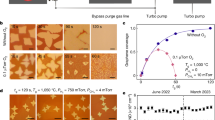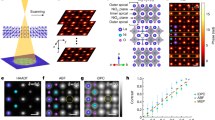Abstract
The excellent photocatalytic properties of titanium oxide (TiO2) under ultraviolet light have long motivated the search for doping strategies capable of extending its photoactivity to the visible part of the spectrum. One approach is high-pressure and high-temperature hydrogenation, which results in reduced ‘black TiO2’ nanoparticles with a crystalline core and a disordered shell that absorbs visible light. Here we elucidate the formation mechanism and structural features of black TiO2 using first-principles-validated reactive force field molecular dynamics simulations of anatase TiO2 surfaces and nanoparticles at high temperature and under high hydrogen pressures. Simulations reveal that surface oxygen vacancies created upon reaction of H2 with surface oxygen atoms diffuse towards the bulk material but encounter a high barrier for subsurface migration on {001} facets of the nanoparticles, which initiates surface disordering. Besides confirming that the hydrogenated amorphous shell has a key role in the photoactivity of black TiO2, our results provide insight into the properties of the disordered surface layers that are observed on regular anatase nanocrystals under photocatalytic water-splitting conditions.
This is a preview of subscription content, access via your institution
Access options
Access Nature and 54 other Nature Portfolio journals
Get Nature+, our best-value online-access subscription
$29.99 / 30 days
cancel any time
Subscribe to this journal
Receive 12 print issues and online access
$259.00 per year
only $21.58 per issue
Buy this article
- Purchase on Springer Link
- Instant access to full article PDF
Prices may be subject to local taxes which are calculated during checkout






Similar content being viewed by others
References
Gratzel, M. Photoelectrochemical cells. Nature 414, 338–344 (2001).
Fujishima, A., Zhang, X. & Tryk, D. A. TiO2 photocatalysis and related surface phenomena. Surf. Sci. Rep. 63, 515–582 (2008).
Chen, X. & Selloni, A. Introduction: titanium dioxide (TiO2) nanomaterials. Chem. Rev. 114, 9281–9282 (2014).
Rajh, T., Dimitrijevic, N. M., Bissonnette, M., Koritarov, T. & Konda, V. Titanium dioxide in the service of the biomedical revolution. Chem. Rev. 114, 10177–10216 (2014).
Diebold, U. The surface science of titanium dioxide. Surf. Sci. Rep. 48, 53–229 (2003).
Di Valentin, C., Pacchioni, G. & Selloni, A. Reduced and n-type doped TiO2: nature of Ti3+ species. J. Phys. Chem. C 113, 20543–20552 (2009).
Zuo, F. et al. Self-doped Ti3+ enhanced photocatalyst for hydrogen production under visible light. J. Am. Chem. Soc. 132, 11856–11857 (2010).
Zuo, F. et al. Active facets on titanium(III)-doped TiO2: an effective strategy to improve the visible-light photocatalytic activity. Angew. Chem. Int. Ed. 51, 6223–6226 (2012).
Chen, X., Liu, L., Yu, P. Y. & Mao, S. S. Increasing solar absorption for photocatalysis with black hydrogenated titanium dioxide nanocrystals. Science 331, 746–750 (2011).
Chen, X., Liu, L. & Huang, F. Black titanium dioxide (TiO2) nanomaterials. Chem. Soc. Rev. 44, 1861–1885 (2015).
Naldoni, A. et al. Effect of nature and location of defects on bandgap narrowing in black TiO2 nanoparticles. J. Am. Chem. Soc. 134, 7600–7603 (2012).
Liu, N. et al. Black TiO2 nanotubes: cocatalyst-free open-circuit hydrogen generation. Nano Lett. 14, 3309–3313 (2014).
Zhou, W. et al. Ordered mesoporous black TiO2 as highly efficient hydrogen evolution photocatalyst. J. Am. Chem. Soc. 136, 9280–9283 (2014).
Liu, N. et al. Hydrogenated anatase: strong photocatalytic dihydrogen evolution without the use of a co-catalyst. Angew. Chem. Int. Ed. 53, 14201–14205 (2014).
Zhang, L., Miller, B. K. & Crozier, P. A. Atomic level in situ observation of surface amorphization in anatase nanocrystals during light irradiation in water vapor. Nano Lett. 13, 679–684 (2013).
Lu, Y. et al. Self-hydrogenated shell promoting photocatalytic H2 evolution on anatase TiO2. Nat. Commun. (in the press).
Van Duin, A. C. T., Dasgupta, S., Lorant, F. & Goddard, W. A. ReaxFF: a reactive force field for hydrocarbons. J. Phys. Chem. A 105, 9396–9409 (2001).
Liang, T. et al. Reactive potentials for advanced atomistic simulations. Annu. Rev. Mater. Res. 43, 109–129 (2013).
Senftle, T. P. et al. The ReaxFF reactive force-field: development, applications and future directions. npj Comput. Mater. 2, 15011 (2016).
Car, R. & Parrinello, M. Unified approach for molecular dynamics and density-functional theory. Phys. Rev. Lett. 55, 2471–2474 (1985).
Reuter, K. & Scheffler, M. Composition, structure, and stability of RuO2(110) as a function of oxygen pressure. Phys. Rev. B 65, 35406 (2001).
Zhao, X., Selcuk, S. & Selloni, A. Formation and stability of reduced TiOx layers on anatase TiO2(101): identification of a novel Ti2O3 phase. Phys. Rev. Mater. 2, 15801 (2018).
Aschauer, U. & Selloni, A. Hydrogen interaction with the anatase TiO2(101) surface. Phys. Chem. Chem. Phys. 14, 16595–16602 (2012).
Gong, X.-Q., Selloni, A., Batzill, M. & Diebold, U. Steps on anatase TiO2(101). Nat. Mater. 5, 665–670 (2006).
Selcuk, S. & Selloni, A. Facet-dependent trapping and dynamics of excess electrons at anatase TiO2 surfaces and aqueous interfaces. Nat. Mater. 15, 1107–1112 (2016).
Yu, J., Low, J., Xiao, W., Zhou, P. & Jaroniec, M. Enhanced photocatalytic CO2-reduction activity of anatase TiO2 by coexposed {001} and {101} facets. J. Am. Chem. Soc. 136, 8839–8842 (2014).
Tachikawa, T., Yamashita, S. & Majima, T. Evidence for crystal-face-dependent TiO2 photocatalysis from single-molecule imaging and kinetic analysis. J. Am. Chem. Soc. 133, 7197–7204 (2011).
De Angelis, F., Di Valentin, C., Fantacci, S., Vittadini, A. & Selloni, A. Theoretical studies on anatase and less common TiO2 phases: bulk, surfaces, and nanomaterials. Chem. Rev. 114, 9708–9753 (2014).
Scheiber, P. et al. (Sub)surface mobility of oxygen vacancies at the TiO2 anatase (101) surface. Phys. Rev. Lett. 109, 136103 (2012).
Cheng, H. & Selloni, A. Energetics and diffusion of intrinsic surface and subsurface defects on anatase TiO2 (101). J. Chem. Phys. 131, 1–10 (2009).
Claus, J., Leonhardt, M. & Maier, J. Tracer diffusion and chemical diffusion of oxygen in acceptor doped SrTiO3. J. Phys. Chem. Solids 61, 1199–1207 (2000).
Barnabel, V. I. & Bogomolov, V. N. Diffusion of defects in rutile during its partial reduction in a vacuum. Sov. Phys. Solid State 11, 2160 (1970).
Barnard, A. S. & Curtiss, L. A. Prediction of TiO2 nanoparticle phase and shape transitions controlled by surface chemistry. Nano Lett. 5, 1261–1266 (2005).
Asahi, R., Taga, Y., Mannstadt, W. & Freeman, A. J. Electronic and optical properties of anatase TiO2. Phys. Rev. B 61, 7459–7465 (2000).
Yang, H. G. et al. Anatase TiO2 single crystals with a large percentage of reactive facets. Nature 453, 638–641 (2008).
Liu, G. et al. Titanium dioxide crystals with tailored facets. Chem. Rev. 114, 9559–9612 (2014).
Wang, G. et al. Computational and photoelectrochemical study of hydrogenated bismuth vanadate. J. Phys. Chem. C. 117, 10957–10964 (2013).
Perdew, J. P., Burke, K. & Ernzerhof, M. Generalized gradient approximation made simple. Phys. Rev. Lett. 77, 3865–3868 (1996).
Anisimov, V. I., Zaanen, J. & Andersen, O. K. Band theory and Mott insulators: Hubbard U instead of Stoner I. Phys. Rev. B 44, 943–954 (1991).
Giannozzi, P. et al. QUANTUM ESPRESSO: a modular and open-source software project for quantum simulations of materials. J. Phys. Condens. Matter 21, 395502 (2009).
Vanderbilt, D. Soft self-consistent pseudopotentials in a generalized eigenvalue formalism. Phys. Rev. B 41, 7892–7895 (1990).
Burgess, D. R. in NIST Chemistry WebBook (eds Linstrom, P. J. & Mallard, W.G.) (NIST, 2017); https://doi.org/10.18434/T4D303
Plimpton, S. Fast parallel algorithms for short-range molecular dynamics. J. Comput. Phys. 117, 1–19 (1995).
Aktulga, H. M., Fogarty, J. C., Pandit, S. A. & Grama, A. Y. Parallel reactive molecular dynamics: numerical methods and algorithmic techniques. Parallel Comput. 38, 245–259 (2012).
Kim, S. Y. et al. Development of a ReaxFF reactive force field for titanium dioxide/water systems. Langmuir 29, 7838–7846 (2013).
Huang, L., Gubbins, K. E., Li, L. & Lu, X. Water on titanium dioxide surface: a revisiting by reactive molecular dynamics simulations. Langmuir 30, 14832–14840 (2014).
Raju, M., Van Duin, A. C. T. & Fichthorn, K. A. Mechanisms of oriented attachment of TiO2 nanocrystals in vacuum and humid environments: reactive molecular dynamics. Nano Lett. 14, 1836–1842 (2014).
Tuckerman, M. E., Alejandre, J., López-Rendón, R., Jochim, A. L. & Martyna, G. J. A Liouville-operator derived measure-preserving integrator for molecular dynamics simulations in the isothermal-isobaric ensemble. J. Phys. A. 39, 5629–5651 (2006).
Acknowledgements
This work was supported by DoE-BES, the Division of Chemical Sciences, Geosciences and Biosciences under award DE-FG02-12ER16286. We used the resources of the National Energy Research Scientific Computing Center (DoE contract number DE-AC02-05CH11231). We also acknowledge use of the TIGRESS High Performance Computer Center at Princeton University.
Author information
Authors and Affiliations
Contributions
A.S. initiated and supervised this research project. S.S. designed the models and the computational approaches, and performed the simulations, their analysis and visualization. X.Z. performed and analysed the DFT cluster calculations of the electronic properties. All authors contributed to discussions and writing the manuscript.
Corresponding author
Ethics declarations
Competing interests
The authors declare no competing interests.
Additional information
Publisher’s note: Springer Nature remains neutral with regard to jurisdictional claims in published maps and institutional affiliations.
Supplementary information
Supplementary Information
Supplementary Sections 1–5, Supplementary Figures 1–18, Supplementary References 1–9
Supplementary Video 1
Surface Reduction
Supplementary Video 2
VO dynamics
Supplementary Video 3
Amorphization Dynamics
Rights and permissions
About this article
Cite this article
Selcuk, S., Zhao, X. & Selloni, A. Structural evolution of titanium dioxide during reduction in high-pressure hydrogen. Nature Mater 17, 923–928 (2018). https://doi.org/10.1038/s41563-018-0135-0
Received:
Accepted:
Published:
Issue Date:
DOI: https://doi.org/10.1038/s41563-018-0135-0
This article is cited by
-
Photochemical tuning of dynamic defects for high-performance atomically dispersed catalysts
Nature Materials (2024)
-
Surface Ir-Ti Alloy Formed via Strong Metal − Support Interaction over Ir/TiO2
Catalysis Letters (2024)
-
Metals Production and Metal Oxides Reduction Using Hydrogen: A Review
Journal of Sustainable Metallurgy (2022)
-
Oxygen vacancies in nanostructured hetero-interfacial oxides: a review
Journal of Nanoparticle Research (2022)
-
Highly stable visible‐light photocatalytic properties of black rutile TiO2 hydrogenated in ultrafast flow
Journal of Materials Science: Materials in Electronics (2021)



